Driver's ED
1/61
There's no tags or description
Looks like no tags are added yet.
Name | Mastery | Learn | Test | Matching | Spaced |
|---|
No study sessions yet.
62 Terms
what type of license to drive a car
noncommercial Class C driver’s license
To apply for an instruction permit or driver’s license, you must provide:
proof of identity, two proofs of residency, legal full name document, social security number
To apply for a Class C instruction permit:
1. Complete a Driver’s License & ID Card Application.
2. Provide your documents.
3. Pay a non-refundable application fee.
4. Pass your knowledge test(s).
5. Pass a vision test.
If you are under 18 years old, you will also need to:
Be at least 15½ years old.
Complete a driver education program.
Have a parent or guardian sign to approve the application and accept financial responsibility
If your parents or guardians share joint custody of you, both must sign.
Wait to use your instruction permit until you start behind-the-wheel driver training with an instructor who will validate the permit.
Driving Schools Driver education and driver training are offered at
DMV-licensed driving schools and some high schools. Instructors must carry an instructor’s ID card. Ask to see it.
To get your driver’s license after you have your instruction permit, you need to:
• Practice driving with a California-licensed driver who is at least 18 years old (25 for minors). This person must sit close enough to take control of the vehicle if needed. • Pass a behind-the-wheel drive test
For drivers license if you are under 18 years old, you will also need to:
• Be at least 16 years old. • Have an instruction permit from California or another state for at least 6 months (or turn 18 years old) before scheduling your behind-thewheel drive test. • Prove that you completed both driver education and driver training. • Practice driving for at least 50 hours with a California-licensed driver who is at least 25 years old. Ten hours must be at night.
When you are under 18 years old, your driver’s license will have the word
provisional
As a provisional driver, you cannot drive:
• Between 11 p.m. and 5 a.m. during the first 12 months you have your license. • With passengers under 20 years old, unless your parent or guardian or other California-licensed driver (at least 25 years old) rides with you. • For pay or operate vehicles that require a commercial Class A, B, or C license.
There are exceptions to these restrictions if you:
• Have a medical need and cannot reasonably find another way to travel. You must carry a note signed by your physician. The note must have your medical condition and date you are expected to recover. • Drive for schooling or a school activity. You must carry a note signed by your school principal, dean, or designee. • Must drive for work reasons. You must carry a note signed by your employer. The note must confirm your employment. • Must drive an immediate family member. You must carry a note signed by your parent or legal guardian. The note must state the reason you need to drive, the family member, and date when the need will end.
A parent or guardian may cancel their teen’s license by completing a
Request for Cancellation or Surrender of a Driver License or ID Card form.
driver's license tests include
vision tests, knowledge tests, and behind the wheel drive test
If you take your vision test with corrective or contact lenses, your driver’s license will have a __________. If you do not pass your vision test, you will be asked to __________________________________________.
corrective lenses restriction
have your eye doctor complete a Report of Vision Examination form.
When you apply for an original driver’s license, you must pass a____________________. You are allowed __________________________. Minors must wait____________________________.
knowledge test with multiple choice questions
three attempts to pass before you must reapply
seven days to retake a failed knowledge test, not including the day of the failure
When you apply for an original driver’s license, you will be tested on _______________________________. Upon renewal, drivers with a vision or medical condition may be required to ________________. The examiner may give two or more instructions at one time to __________________________________.
your ability to safely drive a vehicle
take a behind-the-wheel test
determine whether you can understand and properly follow both directions.
On the day of your behind-the-wheel test, you must bring:
1. Your instruction permit or driver’s license (if you have one). 2. Another California-licensed driver who is at least 18 years old (25 for minors), unless you are already licensed to drive. 3. A vehicle that is safe to drive for your test. 4. Valid proof of insurance and vehicle registration. 5. If you plan to use a rental vehicle for your drive test, your name must be listed on the rental contract. The contract must not exclude behind-the-wheel drive tests
Minors must wait ______ to retake a failed behind-the-wheel drive test, not including the day of the failure.
14 days
Before you begin, the DMV examiner will ask you to locate and demonstrate the following:
• Driver window – The window on the driver side must open. • Windshield – The windshield must allow a full, clear, unblocked view for you and the DMV examiner. Windshield cracks may postpone your test. • Rearview mirrors – At least two rearview mirrors. One of them must be on the left side of your vehicle. • Brake lights – The right and left brake lights must be operational. • Tires – The tires must have at least 1/32-inch of uniformed tread depth. The use of a donut tire is not allowed during a drive test. • Foot brake – There must be at least one inch of clearance between the bottom of the brake pedal and the floorboard when depressed. • Horn – Designed for the vehicle, in proper working condition, and loud enough to be heard from a distance of at least 200 feet. • Emergency (parking brake) – How to set and release the parking brake. • Turn/Arm signals a. Left turn. b. Right turn. c. Slowing down or stopping. • Windshield wipers: control arm or switch – You may be required to show they function. • Seat belts – All seat belts must work properly and be used by the individual(s) in the vehicle.
If your vehicle does not meet the requirements, your drive test will be _________________
rescheduled
If you move, you must notify DMV of your new address within ______ days.
ten
Hand-to-Hand Steering (Push/Pull) To use this steering wheel method:
1. Start with your hands at 9 and 3 o’clock or 8 and 4 o’clock. 2. Do not cross your hands over the middle of the steering wheel. 3. Keep your hands in these positions, even when making turns.
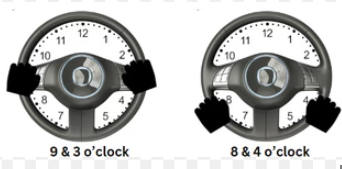
There are only two situations that may require steering with one hand:
• When you are turning while backing up to see where you are going behind you. Place your hand at the 12 o’clock position on the steering wheel. • When you are operating vehicle controls that require you to remove a hand from the steering wheel.
Always signal when you _______________________
turn, change lanes, slow down, or stop.
You can signal using your vehicle’s ______________________
signal lights or using hand-and-arm positions

You should signal:
At least 100 feet before you turn. • Before every lane change. • At least five seconds before you change lanes on a freeway. • Before pulling next to the curb or away from the curb. • Even when you do not see other vehicles around you. • When you are almost through the intersection if you plan to turn shortly after crossing the intersection.
Use your horn to:
• Avoid collisions. • Alert oncoming traffic on narrow mountain roads where you cannot see at least 200 feet ahead.
Dim your high-beam headlights to low beams within _________________________________
500 feet of a vehicle coming toward you or within 300 feet of a vehicle you are following.
It is illegal to drive using only ___________.
parking lights
Use your headlights:
• When it is too dark to see from 1,000 feet away. • Beginning 30 minutes after sunset. • Until 30 minutes before sunrise. • In adverse weather. If you need to use your windshield wipers due to fog, rain, or snow, you must turn on your low-beam headlights. • When conditions (such as clouds, dust, smoke, or fog) prevent you from seeing other vehicles. • On mountain roads and tunnels (even on sunny days). • When a road sign states that headlights must be on. • To help other drivers see your vehicle, especially when the sun is low on the horizon.
If you can see a collision or hazard ahead, warn drivers behind you using these methods:
• Turn on your emergency flashers. • Lightly tap your brake pedal three or four times. • Use a hand signal when slowing and stopping.
If you need to stop because of vehicle trouble:
• Turn on your emergency flashers. If your vehicle does not have emergency flashers, use your turn signals. • If possible, pull off the road away from all traffic. • If you cannot get completely off the road, stop where people can see you and your vehicle from behind. • Do not stop just over a hill or just around a curve. Other drivers may not see your vehicle in time to avoid a collision. • Call for emergency roadside assistance and stay in your vehicle until help arrives.
A traffic lane is a section of road for ________________
a single line of traffic.
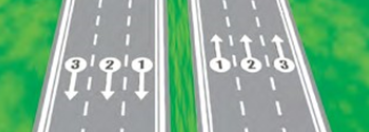
Lane markings on road surfaces help drivers know ______________________________________________
which part of the road to use and understand traffic rules.
A single solid yellow line marks the center of a road with
two-way traffic.

Do not pass a vehicle in front of you if there is only __________________________________________
one lane of traffic going your direction and a solid yellow line on your side of the road.
Do not pass over _______________________ lines
double solid yellow
Stay to the right of double solid yellow lines unless you are:
• In a high-occupancy vehicle (HOV) carpool lane that has a designated entrance on the left. • Instructed by construction or other signs to drive on the other side of the road because your side is closed or blocked. • Turning left across a single set of double yellow lines to enter or exit a driveway or private road or make a U-turn.
Two sets of solid double yellow lines spaced two or more feet apart are considered a _________
barrier

Do not __________________________________ two sets of solid double yellow lines except at designated openings.
drive on or over this barrier, make a left turn, or make a U-turn across it,
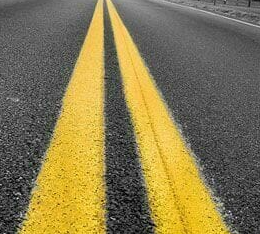
A broken yellow line indicates you may pass if the broken line is _______________________. Only pass when it is safe.
next to your driving lane
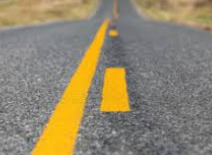
A single solid white line marks __________________________. This includes ______ streets.
traffic lanes going in the same direction
one-way
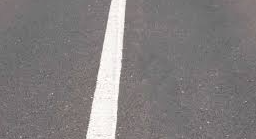
Double solid white lines indicate a lane barrier between _____________________, such as a ________________
a regular use and a preferential use lane
carpool (HOV) lane

You may also see double solid white lines in or near ______________________
freeway on and off ramps
Never change lanes over ___________________. Wait until you see a _______________.
double solid white lines
single broken white line
Broken white lines separate traffic lanes on roads with ___________________________.
two or more lanes in the same direction
Ending freeway and street lanes are usually marked with __________________
large broken lines
If you are driving in a lane marked with broken lines, be prepared to _________________________. Look for a sign that tells you to ________________.
exit the freeway or for the lane to end
exit or merge
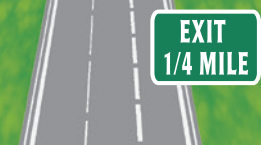
A yield line is a solid white line of __________________________________________. The triangles point towards ____________________.
triangles that shows approaching vehicles where to yield or stop
approaching vehicles
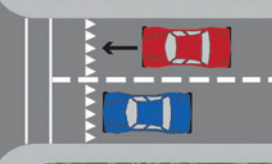
Traffic lanes are often referred to by _______. The left (or fast) lane is called the ____________________. The lane to the right of the Number 1 Lane is called the _____________.
number
Number 1 Lane
Number 2 Lane
Here are some tips for choosing a lane:
• Use the left lane to pass or turn left. • Use the right lane to enter or exit traffic or when you enter the road from a curb or shoulder.
Before you change lanes:
• Signal. • Check your mirrors. • Check traffic behind and beside you. • Look over your shoulder in the direction you plan to move to make sure the lane is clear. • Check your blind spots for other vehicles, motorcyclists, and bicyclists. Do not let the vehicle drift into another lane. • Be sure there is enough space for your vehicle in the next lane. It is not necessary to slow down before a lane change.
Stay in ________ as much as possible. Do not ________________ of traffic. Last minute lane or direction changes may _____________________________. Once you start moving through an intersection, ____________.
one lane
weave in and out
increase the risk of collisions
keep going
If you start to make a turn, ______________. If you miss a turn, keep driving until you can __________________.
follow through
safely and legally turn around
On a multilane road, the passing lane (far left lane) is the lane ________________________________.
closest to the center divider and is used to pass other vehicles
An HOV lane is a special lane reserved for _________________________________________________.
carpools, buses, motorcycles, or low-emission vehicles with decals
To use an HOV lane, one of these must apply:
You have a certain number of people in your vehicle. There will be signs at the on-ramp or along the road to tell you the minimum number of people. Road signs also list the hours when the HOV rules apply. • You are driving a low emission or zero emission vehicle. You must display a special DMV-issued decal. • You are riding a motorcycle (unless otherwise posted.
The road surface in an HOV lane is marked with a ____________________________. Do not cross over_________________________. Use ____________________.
diamond symbol and the words Carpool Lane
double solid lines to enter or exit an HOV lane
designated entrances and exits
A center left turn lane is located in the ____________________. It is marked on ____________________. The inner line is ________________________.
middle of a two-way street
both sides by two painted lines
broken and the outer line is solid
Use the center left turn lane to prepare for and make a _______________. It is not a regular __________________. You may only drive for______________.
left turn or U-turn
traffic lane or passing lane
200 feet in the center
To turn left from this lane:
• Look for other vehicles coming toward you in the center left turn lane. • Signal. • Look over your shoulder to check your blind spots. • Merge completely into the center left turn lane so you do not block traffic. • Turn when it is safe.
Some two-lane roads have special ______________. Merge into these areas or lanes to _________________.
turnout areas or lanes
allow cars behind you to pass
You must use a turnout area or lane to:
let other vehicles pass when you are driving slowly on a two-lane road, where passing is unsafe, and there are five or more vehicles following you.